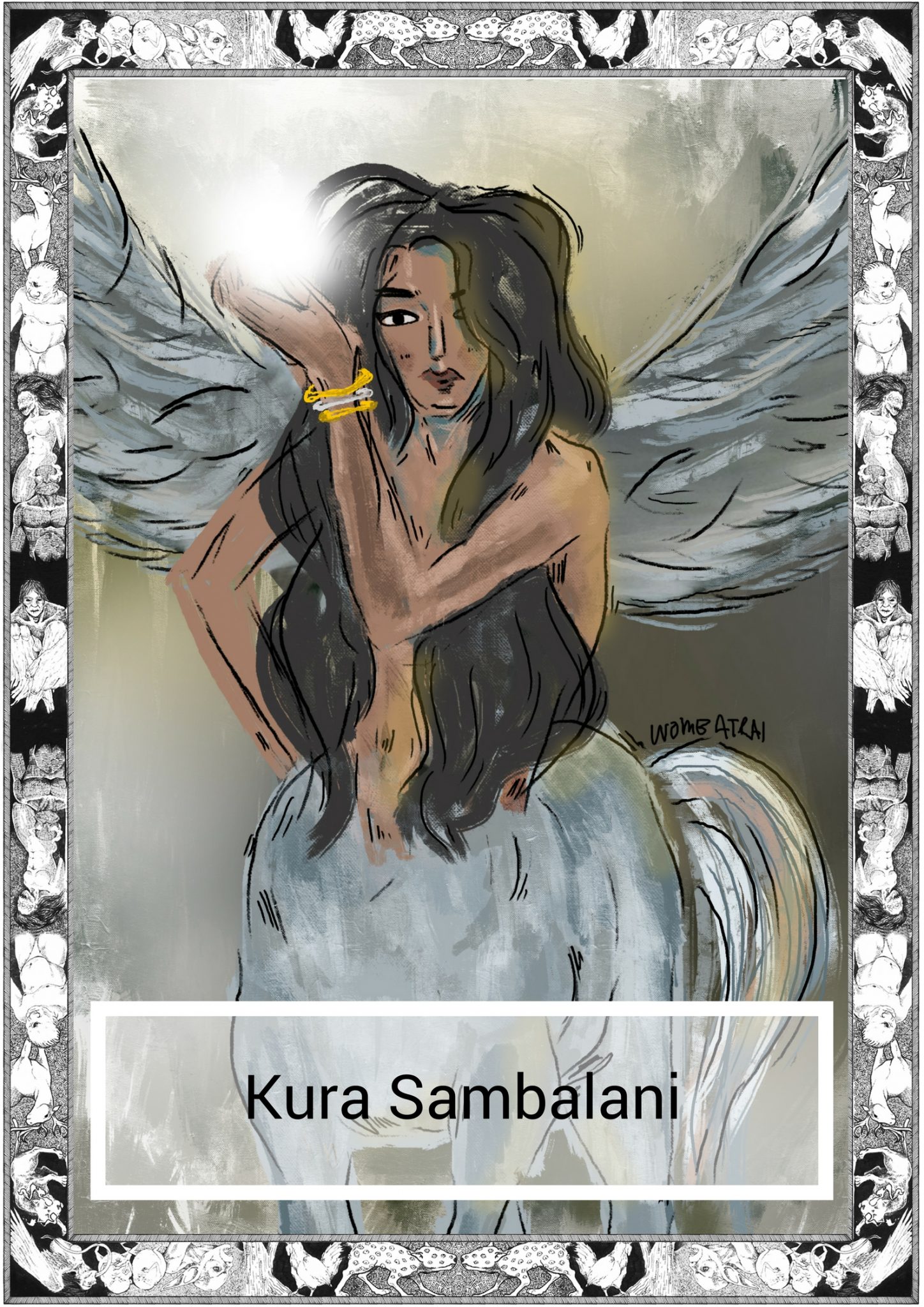
*Note this story is in Ilocano
Payyak a puraw.
Rupa ti babai.
Bagi ti kabalyo.
Nagsilnag ti kinaraniag nga agtaud kenkuana kadagiti diding ti balay a kasla agsalsala nga apoy a nakasango iti tallaong.
Binalakadan idi ti inana a saanna pulos a taliawen daytoy, ngem saan a makaidna ni Rai a mangsirip iti nagbabaetan ti ramayna. Ammona dagiti pakasaritaan dagiti datdatlag a pinarsua, no man pay aminda nga ub-ubbing ket ammoda. Ngem sabali laeng no isuna mismo ti makakita iti sangonsango.
“No man bilang siak ti nainkalintegan nga anak dagiti dadakkelko, dawatek ngarud dagiti sumaganad a sagut manipud kenni Allah, ti Kangatoan: ‘Sapay koma ta ti Kura Sambalani, argaman ti pirak ken balitok a pulserasna, ket agparang ken umay ditoy lubong manipud law-ang iti mamimpito a daras. Sapay koma ta yegna pay kaniak dagiti kawes nga insuot dagiti daddakelko iti aldaw ti panagkallaysada tapno isuotko met.’”
Dayta ti dinamag ni Tuwan Putli iti kata-kata2 ni Manik Buwangsi, ti sarsarita nga ammona a sipupuso. No agsakay ni Tuwan Putli iti Kura Sambalani, ti lawag dayta a pinarsua, malaksid ti kinapintas ni Tuwan Putli, ket isu ti makagapu unay no apay a masinga dagiti agparparti ti baka para iti pasken a pakaputdan kadagiti ramayda.
Nasdaaw ni Rai iti nakitana. Insakay ti Kura Sambalani ti natay nga imam iti likodanna ket inruginan ti nagtayab a nangturong ti langit.
Ti imam ket nasantoan unay a tao, saan ngarud a nakaskasdaaw a ti Kangatoan ket mangibaon iti maysa kadagitoy a nailangitan a pinarsua tapno itayabna daytoy idiay langit.
Saan a masinunuo ni Rai no ania ti nanglugan kenkuana nga agsao, ngem manipud iti ngiwatna naisawang dagitoy a balikas, “Nasantoan! Pangngaasim ta sungbatam ti saludsodko!”
Nagsardeng ti panaganges dagiti nakitaripnong bayat ti panagur-urayda iti sungbat. Pinadas ni Rai a miningmingan no adda pagilasinan ti kaririknana iti rupana, ngem mapurar dagiti matana iti lawag daytoy.
Nagsardeng ti Kura Sambalani iti panagtayabna ket nagtapaw iti sango ti ubing.
Saan a nagduadua ni Rai, “Mabalin kadi nga ipannak kenni amak?”
Iti likodanna, nagsennaay ti inana.
Nagwingiwing ti Kura Sambalani ket timmalikod.
Ket nagyaman ni Rai iti maudi a gundaway bayat ti panangitayabna ti imam idiay langit.
Immisem ni Rai kas ti isem ti maysa a makaammo a ti pananggun-od iti gundaway no dadduma ket isu ti bukod a gunggona.
_____________________
1Ti Kura Sambalani ket kadawyan a mailadladawan a kas maysa a puraw wenno karkarna a kabalio a mangitayab kadagiti kararua dagiti mararaem a tao nga agturong idiay langit wenno iti panagbiag kalpasan ti ipapatay. Iti sumagmamano a pakasaritan, ti Kura Sambalani ket nailadawan a kas maysa a pinarsua a puraw ti payakna, kagudua a kabalio ken kagudua a tao nga addaan iti rupa ti maysa a babai (kas nailadawan iti kaunaan a sarsarita ti Tausug a nakaibatayan iti daytoy a sarita. Daytoy a kayulogan ti Kura Sambalani ket naadaw manipud iti Buraq/Burak, maysa a pinarsua iti Islamiko a kannawidan a mangisalakan kadagiti propeta).
2Marchen wenno sarsarita a Tausug.
=—————————————=
English Version
White wings.
A woman’s face.
A horse’s body.
“If I am the legitimate daughter of my parents, I wish for the following gift from Allah, the Most High: ‘May my Kura Sambalani with her silver and gold bracelet, show up and come from outer space to this world seven times. May she bring me the clothes that my parents wore on their wedding day so that I could wear them.’”
That was what Tuwan Putli’ asked in the kata-kata* of Manik Buwangsi’, a tale she knew by heart. Tuwan Putli’ would ride the Kura’ Sambalani and the light from the creature in addition to Tuwan Putli’s beauty were so great that they distracted those that were slaughtering cows for the feast causing them to cut their fingers.
Rai could only stand dumfounded at the sight that she beheld. The Kura’ Sambalani carried the deceased imam on her back and she began to fly towards heaven.
The imam was an especially pious man and it was no surprise that the Most High would send one of these celestial creatures to carry him to heaven.
Rai didn’t know what possessed her to speak, but the words flowed from her mouth. “Holy One! Please answer my question!”
Breaths stopped as those gathered waited for a response. Rai tried to see if there was any trace of emotion on her face, but the light hurt her eyes.
The Kura’ Sambalani stopped her ascent and floated in front of the child.
Rai didn’t hesitate “Can you take me to see my father?”
From behind her mother let out a gasp.
The Kura’ Sambalani shook her head and turned away.
Rai let out one final “Thank you” as she and the imam flew towards heaven.
Rai smiled the smile of someone that knew that taking a chance is sometimes its own reward.
*Tausug folktale
**The Kura Sambalani is usually described as a white/ wondrous horse that brings the spirits of venerated persons to heaven/ the afterlife. In some folktales the Kura Sambalani is described as a white winged being, half horse and half human with a woman’s face (as described in the original Tausug folktale this story is inspired by. This version of the Kura Sambalani is heavily influenced by the Buraq/Burak, a creature in Islamic tradition that transported prophets.
=———————–=
*Ilocano is the third most-spoken local language of the Philippines.An Austronesian language, it is related to such languages as Malay (Indonesian and Malaysian), Tetum, Chamorro, Fijian, Maori, Hawaiian, Samoan, Tahitian, Paiwan and Malagasy. It is closely related to some of the other Austronesian languages of Northern Luzon, and has slight mutual intelligibility with the Balangao language and the eastern dialects of the Bontoc language.
Written by Karl Gaverza
Ilocano translation by Deo M. Ramos
Copyright © Karl Gaverza
Translation Copyright © Deo M. Ramos
Inspired by the Kura Sambalani description in Manik Buwangsi’. Narrated by Mullung. in Voices from Sulu A Collection of Tausug Oral Traditions. Rixhon. 2010.
Kura’ Sambalani Illustration by Rai Hamid
FB: Wombatrai
